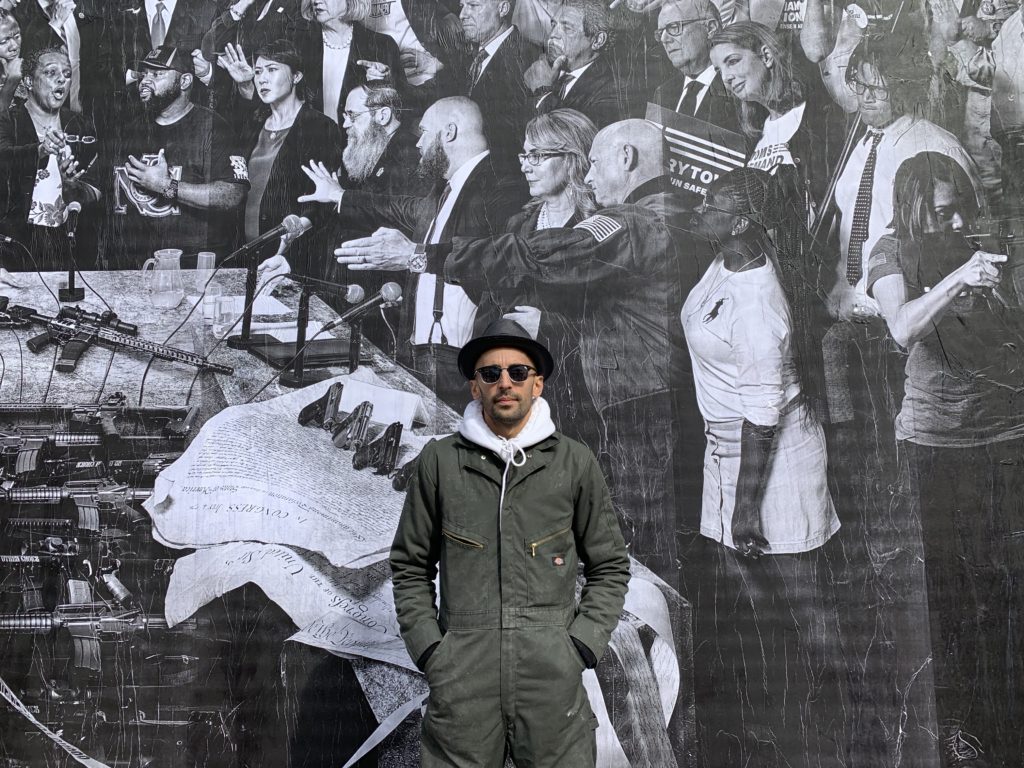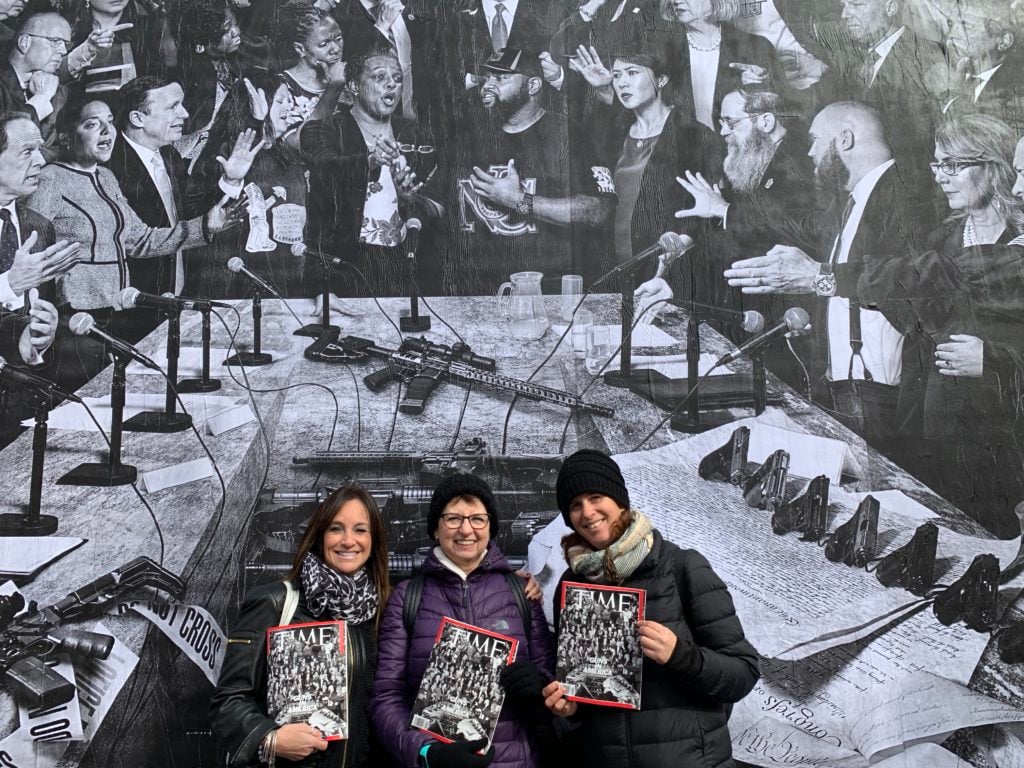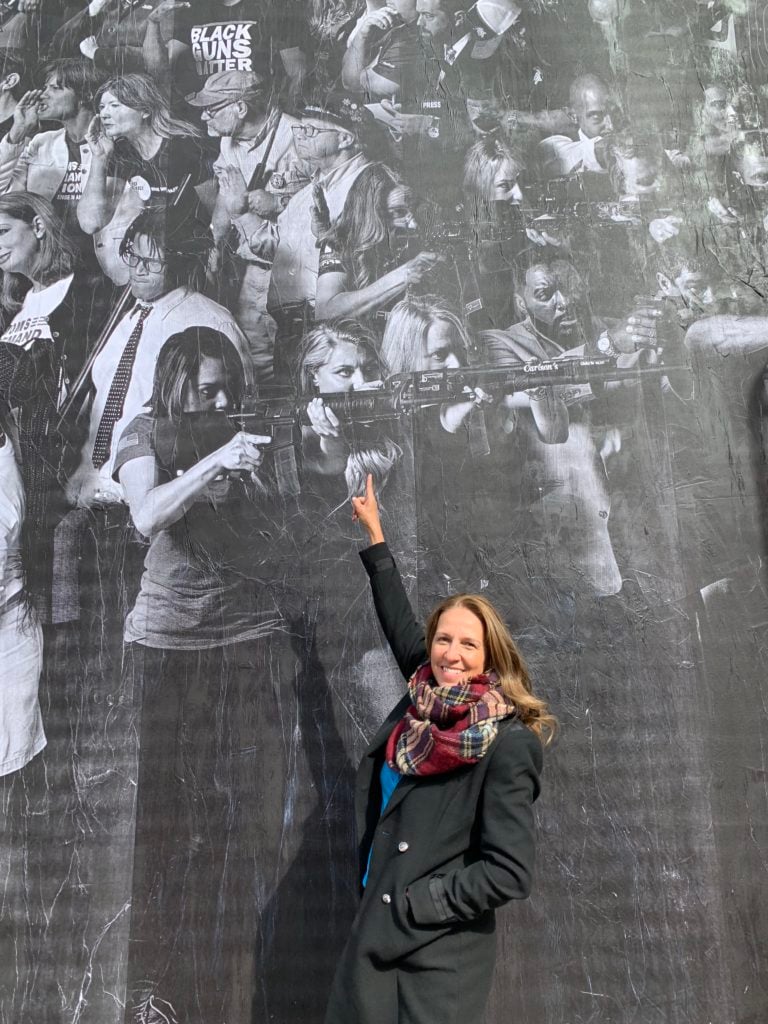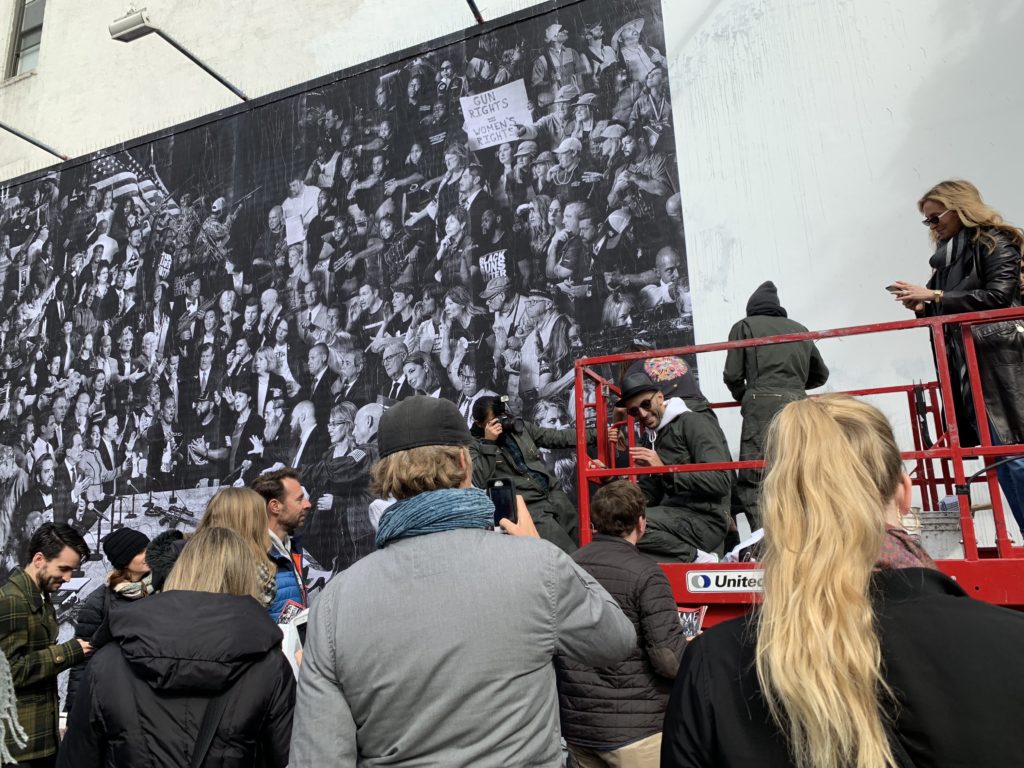People
Artist JR on Why He’s Glad ‘Everybody on the NRA Side Has Loved’ His Epic Mural About America’s Gun Crisis
The artist has a show at Pace and a mural on the Bowery.

The artist has a show at Pace and a mural on the Bowery.

Sarah Cascone

When French street artist JR teamed up with TIME magazine on his multimedia project “Guns in America,” he was hoping to get the public’s attention and to inspire people across the US to engage in meaningful conversation about gun violence. If the early response is any indication, it would seem that the artist has already accomplished at least one of those goals.
It was standing room only at Pace Gallery in Chelsea on Thursday night, where the artist joined representatives of TIME and some of the project’s 245 participants to talk about the gun debate and the search for common ground on a deeply divisive issue. A massive video mural featuring staunch gun control advocates as well as avid gun enthusiasts is on view on 24th Street through November 3, courtesy of FuturePace.
For the project, JR has also made one of his signature pastings, a still version of the massive image, which also graces the magazine’s November 5 issue, on the Bowery Wall, one of the city’s best-known spots for sanctioned street art. (He’s the only artist to take over the wall twice.) JR’s team of eight, outfitted in matching jumpsuits to keep from ruining their clothes with wheatpaste, arrived at about 9 a.m. at the wall Friday morning. Two hours later, they were almost finished, despite delays thanks to the crowds mobbing the artist, who was clad as always in a sunglasses and hat.
Someone from TIME was handing out magazines, and JR was dutifully signing autographs, almost as if cementing his status—after last year’s Oscar nomination for his film Faces Places—as a rock star of the art world. “This one is for the girl in the coffee shop around the corner,” said one man, brandishing two magazines. “She said she loves you, so I said I’d come back and get one for her.”

Cari Elpren, Helene Landau, and Dana Landau with JR’s “Guns in America” mural. Photo by Sarah Cascone.
Others had turned up specifically to see the artist in action. Helene Landau and her daughter Dana Landau, were in New York to see a friend, but Dana, a photographer, had been eager to see JR’s latest work. The Landaus live in Israel, where JR had once done a pasting on their Kibbutz, which they had saved upon its deinstallation.
There was even one of the mural’s subjects on hand for its public unveiling: Dianna Muller, a former cop and champion competitive shooter from Tulsa, Oklahoma. “I was definitely skeptical” about participating in the project, she admitted to artnet News. “But I didn’t want them to talk to somebody else. I feel like I’m your average gun owner, and I wanted to make sure that our side was heard.”

Dianna Muller points to herself in JR’s “Guns in America” mural. Photo by Sarah Cascone.
As tourists and fans lined up, JR was unfazed by all the attention, decidedly optimistic that the piece was already having an impact. “These people walking by, that’s where the conversation starts. It’s when people start listening to everybody,” he told artnet News, citing the feedback from participants in the mural who held diametrically opposed points of view, but found that they were able to learn a lot from one another. “They were speaking for hours and realized they had more in common than they thought!”
Sadly, the mural’s undeniable timeliness was underscored just a day later, when a man opened fire at a synagogue in Pittsburgh. As reported by Bowery Boogie, the mural was tagged with the number 11 in bright red, representing the number of victims killed in the nation’s latest mass shooting.
During the mural’s installation, artnet News spoke with JR about the challenging project, its implications, and his hopes for the outcome.
What did you learn interviewing all these people while you were making this artwork?
It’s really a project that I didn’t know anything about. I’ve lived in the US for eight years, but I don’t think living in New York tells you a lot about the real debate that is going on in this country. Going to cities like St. Louis and Dallas, and DC, where the laws are being made, to meet people from all sides of the spectrum, and hear their point of view, their story, their fear—fear is really something that I’ve been hearing about a lot on each side—I’ve learned a lot.
I’ve realized it is a time for a real conversation. I had the feeling that both sides had not had the chance to really hear each other. They would often say the same thing [from] a different perspective but on the same ground. That’s why I wanted to give everyone their own voice, so you can hear every single story. It’s uncut, so if you go to the site or the app you can hear every story completely. I don’t want it to take any side.
Why partner with the media on this project?
TIME helped me to get access to people who I wouldn’t normally have access to, to make sure it would be balanced. To create a real conversation, there’s much more we have to do. With the fake news and all that, it’s more of a challenge to get into a real conversation.
What were some of the technical challenges of making this piece?
For a video mural, much like a photo mural, when a person comes, I have to know exactly where to place them. The people are moving, and it’s a long loop. You can’t have their arm cross someone else’s face. You have to make sure it all works together over a long loop. We needed to be very precise the whole time. People would come with their own firearms and ideas of how they wanted to be represented, and I had to take all this into consideration, to make it all match.
What kind of response are you getting to the project so far?
If you go on Twitter, every single person in the mural has been thanking the project and sharing it and explaining what it means to them to be represented. Everybody on the NRA side has loved and reposted and shared the mural because they felt represented.
The work I’ve made over the years are simple images that represent people, simple and direct.

JR signs autographs for the public during the installation of his “Guns in America” mural. Photo by Sarah Cascone.
When I was reading the interviews with the project’s subjects in TIME, I was moved to tears. How do you deal with engaging with such emotional subject matter?
For my project Women Are Heroes, 10 years ago, I was in Sudan, Liberia, and Sierra Leone. I heard some really heavy stories. I never thought I would hear as heavy stories here in the US, so I was really surprised. I would go to some places, just take a flight for two hours, and I feel I went to a completely different country that I don’t know, actually. What is going on? I realize that this is actually happening.
I think my role as an artist is to raise questions, not to give answers. To really let the people speak and give them a voice through this mural. Of course I was very touched and moved by some of these stories. You cannot not be touched by them. They are very striking.
This interview has been edited and condensed for clarity.
“Guns in America: A TIME and JR Project” is on view at Pace, 537 West 24th Street, New York, October 26–November 3, 2018.